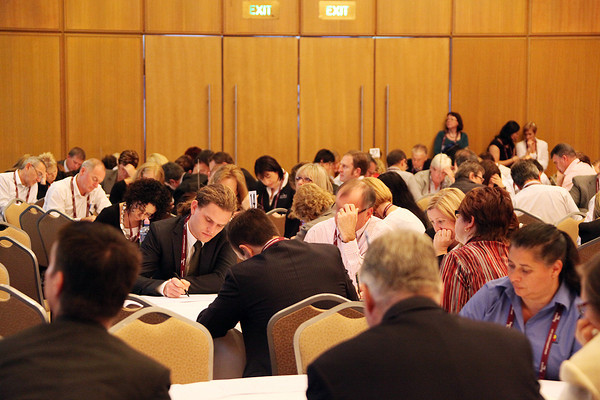As a strategic planning facilitator I have helped design and run hundreds of conferences, workshops and away days for management and leadership groups over the years.
Here are a few suggestions to ensure your next conference is a raging success:
1. Be clear on the conference objectives
It is my experience that many leaders hold a conference because they always have done so.
It seems to me that they are acting out of habit rather than a firm commitment that this is a great initiative.
One way to avoid this mindset is to be crystal clear on what are the objectives of the conference.
For example, is it to launch a new product or build networking opportunities or build greater engagement within the team or develop a strategic plan etc?
Whatever the objectives, these should be clear, explicit, communicated to all delegates and have a tangible way of being measured.
In this way you know for certain whether the conference is a success based on whether it met the initial objectives (e.g. you can conduct a survey during and after the conference).
2. Create a conference brand, theme or identity
The most memorable conferences I have facilitated or attended always had a distinct theme attached to them.
In a sense, the organisers created a memorable brand or identity for each conference.
And like any great brand there was a compelling narrative built into the theme.
This narrative answered such questions as what this conference is all about (e.g. This is the year of innovation) and why it is important (e.g. our competitors are closing in on us).
The theme of the conference should be believable, easily understood and create a sense of urgency or action.
3. The location should align with the objectives & theme
Once the objectives and theme of the conference has been established the organising team should select a location.
My suggestion is that the location should fit with the theme of the conference.
For example, I once designed a day long new product development day with the brand team of a kid’s brand.
The location we selected was at a kid’s museum with a playground next door with the workshop starting and ending to coincide with school hours.
At lunchtime the participants could go and play on the equipment to their heart’s content.
This was a great way to experience the world of a younger consumer and unleash the playfulness and inner child of all participants.
4. Invite your future leaders as well
One of the common mistakes i see leaders make with conferences is that they only invite their current leadership team.
Whilst this is a good idea in terms of building team work the problem is that there is a lack of diversity of perspectives and experiences.
I believe a better idea is to also invite the future leaders of the organisation and potentially any award winners throughout the year.
In this way there can be genuine discussion and sometimes disagreement about the important issues facing the organisation and hence the chances of a more original solution are greatly increased.
Additionally each conference becomes a key learning opportunity for the future leaders of the business.
5. Every presentation should be no more than 40 minutes then run an Ideas Blitz
There is nothing like sitting through hundreds of powerpoint slides to deaden the energy in a conference.
To avoid this situation here is my suggestion.
Have every presentation no more than 1 hour of which 40 minutes is spent communicating the material with no more than 9 slides.
In the remaining 20 minutes the presenter must pose a challenge to the group they are struggling with and would like some new ideas and solutions.
They can then run an Ideas Blitz on the issue, problem or opportunity.
An Ideas Blitz is a short, concentrated, semi-structured creativity tool.
In this way each presentation becomes an opportunity to learn, the crowd solves a real problem and interest and energy in the room is given a real boost.
If you have the best and brightest people away for a few days then why not use their passion, creativity and expertise. T
rust me — with these instructions to all presenters your audience will love you.
6. Incorporate some mystery
One of the best conferences I helped design and facilitate was with a group of leaders of an international hotel chain in the South Island of New Zealand.
At lunchtime on the first day there was a mystery tour built into the agenda.
This created comments, questions and a keen sense of anticipation throughout the morning.
At the allocated time we were all taken up to the top of mountain for a wonderful helicopter ride to a nearby golf course for lunch.
This mystery created a sense of drama and shared experience among the group as we all had experiences something quite beautiful.
The key lesson is that every conference should have some peak experiences that are surrounded in a bit of mystery.
7. Have fun
This is self-explanatory. Leaders and managers all work hard all year so every conference should encourage plenty of time to relax, socialise with one another and have some fun.
It builds team spirit and from my experience lots of work is still discussed, argued and new ideas developed.
8. End with 3 to 5 big action items.
Another big mistake that many conference leaders make (I believe) is their emphasis on the small issues whilst the big ones are ignored or given short shift. For example, I once attended a conference where a problem with worker safety was highlighted.
Rather than the leadership team stopping the conference and say (as I suggested) ‘look this problem cannot continue so lets develop some immediate solutions before we move on’, the planned agenda was resumed and the problem was delegated to a committee.
A game-changing conference is one that energises the delegates or participants and where they are tackling the big, important issues facing the group.
And in particular, this translates to making a significant start on the big challenges and developing action plans on these rather than making incremental progress on the 90 or so smaller ones.
Conferences, strategic planning workshops and away days are vital to the health of the management and leadership team and to the organisation.
But for too long, too much time, effort and money have been wasted.
Using the suggestions I have outlined here will ensure that your next conference will be the best one yet.

